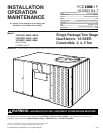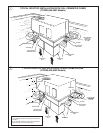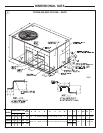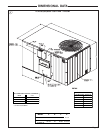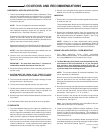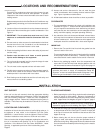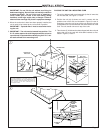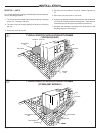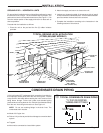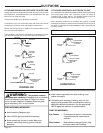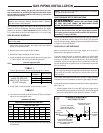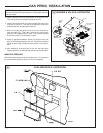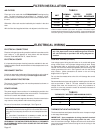
Page 8
LOCATIONS AND RECOMMENDATIONS
15. Access and service clearances for the unit must be given
careful consideration when locating the duct entrance open-
ings. Figure 4 provides unit dimensions.
16. All fabricated outdoor ducts should be as short as possible.
CLEARANCES
1. The recommended clearances for single-unit installations are
illustrated in Figure 4. These minimum requirements are not
only an important consideration when determining unit place-
ment, but they are also essential to ensure adequate service-
ability, maximum capacity, and peak operating efficiency.
2. Any reduction of the unit clearances indicated in these illustra-
tions may result in condenser coil starvation or the recirculation
of warm condenser air. Actual clearances which appear to be
inadequate should be reviewed with a local sales engineer.
IMPORTANT:
1. Remove the Flue and Air Inlet Hood with the gasket from the
return air section of the unit.
The screws that attach the flue and air inlet hood will be installed
in their proper location at the factory. Therefore, they must be
removed and then used to attach the flue and air inlet hood.
2. Remove the packaging material from the components and
secure the Flue and Air Inlet Hood with the gasket to the unit
with sheet metal screws as illustrated in Figure 16 on page 14.
NOTE: Outdoor air or other requirements during heating
operation that result in supply air temperatures below 80
degrees F or return air temperatures below 50 degrees F may
cause flue gas condensate to form and is to be avoided.
INSTALLATION
UNIT SUPPORT
If the unit is to be roof mounted, check the appropriate building
codes for weight distribution requirements. Refer to the applicable
roof curb mounting instruction. Check the unit’s nameplate for
supply voltage required. Determine if adequate electrical power is
available. The furnace may be installed on Class A, B, or C roofing
material.
LOCATION AND CLEARANCES
Installation of the unit should conform to local building codes or, in
the absence of local codes, to the National Fuel Gas Code,
ANSIZ223.1, Latest Revision, and the National Electrical Code.
Canadian installations must conform to CSA and local codes.
Select a location that will permit adequate combustion and ventila-
tion air in accordance with Section 5.3, Air For Combustion and
Ventilation, of the National Fuel Gas Code, ANSIZ223.1, Latest
Revision, or applicable provisions of the local building code.
PLACING AND RIGGING
1. Before preparing the unit for lifting, check the outline drawing for
center of gravity for lifting safety. Because of placement of
internal components, the unit’s weight may be unevenly distrib-
uted. Approximate unit weights are given in Figure 2, page 3.
NOTE: Accessory BAYLIFT002AA, a kit of four (4) lifting lugs, is
required for rigging the unit for hoisting. See Figure 7, insert B.
2. Insert the four lifting lugs in the openings provided in the drip lip
on the perimeter of the unit. See Figure 7, insert B. A tap or jerk
to the lug will overcome the interference that arises due to the
nipple on the lug.
3. Before hoisting the unit, be sure that the proper method of
rigging is used, with straps or slings and spreader bars for
protection during lifting. Always test-lift the unit to determine the
exact unit balance and stability before hoisting it to the installa-
tion location.
continued from page 7
Examine all flue product-carrying areas of the furnace, its vent
system, and the main burner for safe operation. A periodic
inspection of the furnace should be made at the start of each
heating season.
Replacement parts list for this Gas/Electric Air Conditioner may
be obtained by contacting your local manufacturer representa-
tive.
6. Location of the unit must allow for service clearance around it.
Clearance of the unit must be given careful consideration. See
Figure 4.
7. IMPORTANT: The air outlet duct must have one (1) inch
clearance to combustible material downstream from the
unit.
8. Exhaust vents or other sources of contaminated air should not
be near the unit’s air inlet, if outside air is to be introduced as
makeup air or a ventilation feature is to be used.
9. Check the handling facilities to ensure the safety of personnel
and the unit(s).
10. Caution must be taken at all times to avoid personal
injuries and/or damage to the equipment.
11. The unit must be mounted level for proper drainage of water
through the holes in the base pan.
12. The unit must not be exposed to direct roof water runoff.
13. Flexible duct connectors must be of a flame retardant material.
All duct work outside of the structure must be insulated and
weatherproofed in accordance with local codes.
14. Roof flashing must be installed to seal the roof curb cavity and
must conform to local building codes.



